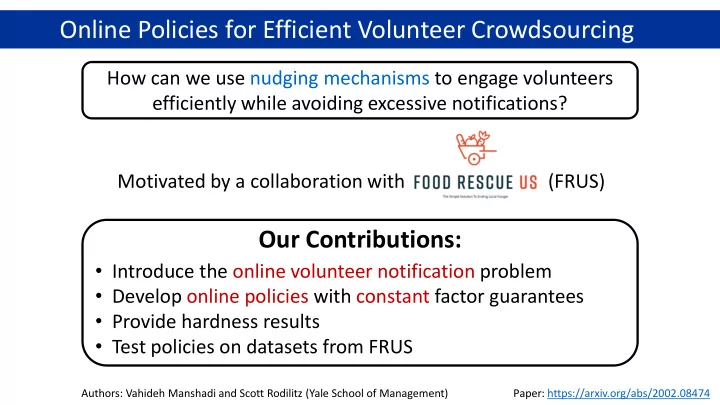

Online Policies for Efficient Volunteer Crowdsourcing How can we use nudging mechanisms to engage volunteers efficiently while avoiding excessive notifications? Motivated by a collaboration with (FRUS) Our Contributions: • Introduce the online volunteer notification problem • Develop online policies with constant factor guarantees • Provide hardness results • Test policies on datasets from FRUS Authors: Vahideh Manshadi and Scott Rodilitz (Yale School of Management) Paper: https://arxiv.org/abs/2002.08474
Online Volunteer Notification Problem • 𝑊 : set of volunteers and 𝑇 : set of task types • Task arrival: At time t task 𝑡 becomes available w. p. 𝝁 𝒕,𝒖 ( σ 𝑡∈𝑇 𝜇 𝑡,𝑢 ≤ 1 ) • Volunteer state (active/inactive): Initially active. • Match prob.: If active & notified about 𝑡 , volunteer 𝑤 responds w. p. 𝒒 𝒘,𝒕 • If an active volunteer is notified, she becomes inactive for 𝜐 periods • Inter-activity time distribution: 𝜐 Example: We can notify each volunteer every two days 2 = 1 Challenging Objective: maximize expected # of completed tasks over 𝑈 tomorrow today time periods (submodular in notified subset) 𝑡 ′ arrives w.p. 𝜇 𝑡 ′ ,2 𝑡 arrives w.p. 𝜇 𝑡,1 Donation 𝑞 𝑣,𝑡 Goal: design online notification policies 𝑞 𝑤,𝑡 𝑞 𝑣,𝑡 ′ that perform well compared to a Volunteer “clairvoyant benchmark” 𝑤 𝑣
Summary of Theoretical Results • Parameterized based on minimum discrete hazard rate of inter-activity time distribution: (𝜐) q = min 1 − 𝐻(𝜐 − 1) 𝜐 Theorem [Lower Bound]: There exists a non- adaptive randomized online policy that achieves 1 Competitive ratio 1 𝑓 at least 1 − Τ 2−𝑟 of our benchmark. Theorem [Upper Bound]: If 𝑟 = 1/𝑜 for some integer 𝑜 , no online policy can achieve better than 𝑟(1−𝑟)(1−𝑓 −1 ) 1 (1+q)log(1−𝑟) of our benchmark. 𝑛𝑗𝑜 2−𝑟 , 1 + 𝑟 + 𝑟
Sparse Notification Policy (SNP) Key Idea: Sparsify an ex-ante solution 𝒚 ∗ by solving a sequence of “low - dimensional” DPs Offline Phase: Artificially rank volunteers. Starting with 𝑤 = 1 and 𝑢 = 𝑈 , 𝐾 𝑤,𝑢+1 ∗ Reward of notifying 𝑤 about 𝑡 at 𝑢 ≥ Reward of not notifying 𝑤 at 𝑢 𝑧 𝑤,𝑡,𝑢 = ቊ𝑦 𝑤,𝑡,𝑢 0 SNP vs. FRUS Current Practice 𝑞 𝑤,𝑡 ෑ 1 − 𝑞 𝑣,𝑡 𝑧 𝑣,𝑡,𝑢 + 𝜐 − 𝑢 𝑲 𝒘,𝝊 1≤𝑣≤𝑤−1 𝑢+1≤𝜐≤𝑈 Fraction of benchmark Expected future number of rescues Solution of higher completed by 𝑤 (if active at 𝜐 ) ranked DP’s 𝐾 𝑤,𝑢 = σ 𝑡∈𝑇 𝑧 𝑤,𝑡,𝑢 (Reward of notifying 𝑤 about 𝑡 at 𝑢 ) +(1 − 𝑧 𝑤,𝑡,𝑢 ) (Reward of not notifying 𝑤 at 𝑢 ) Online Phase: If task 𝑡 arrives at time 𝑢 , notify volunteer 𝑤 with prob. 𝑧 𝑤,𝑒,𝑢
Recommend
More recommend